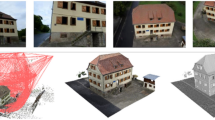Abstract
The rapid development of the Internet promotes that XML is increasingly accepted as a medium for integrating and exchanging data. Meanwhile, object-oriented database with many excellent properties has been applied more and more widely. In particular, considering the need of processing the fuzzy spatiotemporal data existing in practical applications, we study the methodology of building fuzzy spatiotemporal data model and transforming fuzzy spatiotemporal data from XML to object-oriented database as well. To establish a suitable model, we devise a fuzzy spatiotemporal data model in XML to capture the semantics of fuzzy spatiotemporal features. In addition, we take the object-oriented schema that best describes the exciting fuzzy XML Schema and the characteristics of the XML tree structure into account to develop a series of rules to map spatiotemporal data from XML to object-oriented database. Such mapping rules could provide a significant consolidation of the interoperability of fuzzy spatiotemporal data from XML to object-oriented databases.










Similar content being viewed by others
References
Bai LY, Yan L, Ma ZM (2013) Determining topological relationship of fuzzy spatiotemporal data integrated with XML twig pattern. Appl Intell 39(1):75–100
Bai LY, Yan L, Ma ZM (2014) Querying fuzzy spatiotemporal data using XQuery. Integrated Computer-Aided Engineering 21(2):147–162
Bai LY, Yan L, Ma ZM (2015) C.M. Xu, transforming fuzzy spatiotemporal data from XML to relational databases. Appl Intell 43(4):707–721
Bertino E, Guerrini G, Merlo I (2005) Extending the ODMG object model with triggers. IEEE Trans Knowl Data Eng 16(2):170–188
F. Dahak, M. Boughanem, A. Balla, A probabilistic model to exploit user expectations in XML information retrieval, Inf Process Manag 53(1) (2016), 87–105
Frihida A, Marceau DJ, Theriault M (2002) Spatio-temporal object-oriented data model for disaggregate travel behavior. Trans GIS 6(3):277–294
Kim W (1990) Object-oriented databases: definition and research directions. IEEE Trans Knowl Data Eng 2(3):327–341
Li N, Bai LY (2018) Transforming fuzzy spatiotemporal data from relational databases to XML. IEEE ACCESS 6:4176–4185
Liu J, Ma ZM (2013) Formal transformation from fuzzy object-oriented databases to fuzzy XML. Appl Intell 39(3):630–664
Liu J, Yan DL (2016) Answering approximate queries over XML data. IEEE Trans Fuzzy Syst 24(2):288–305
Liu J, Zhang XX (2017) Efficient keyword search in fuzzy XML. Fuzzy Sets Syst 317:68–87
Liu J, Ma ZM, Feng X (2013) Formal approach for reengineering fuzzy XML in fuzzy object-oriented databases. Appl Intell 38(4):541–552
Liu J, Zhang XX, Zhang L (2017) Tree pattern matching in heterogeneous fuzzy XML databases. Knowl-Based Syst 122:119–130
Maler E, Yergeau IF, Cowan J (2006) Extensible markup language (XML) 1.1, World Wide Web Consortium
Martens W, Neven F, Niewerth M, Schwentick T, Xai B (2015) Combining the simplicity of DTD with the expressiveness of XML schema. In: Proceedings of the 34th ACM SIGMOD-SIGACT-SIGAI Symposium on Principles of Database Systems, New York, vol 2015, pp 145–156
Murata M, Lee D, Mani M, Kawaguchi K (2005) Taxonomy of XML schema languages using formal language theory. ACM Trans Internet Technol 5(4):660–704
Naser T, Kianmehr K, Alhajj R, Ridley MJ (2007) Transforming object-oriented databases into XML. In: Proceedings of the 2007 I.E. international conference on information reuse and integration, Las Vegas, pp 600–605
Naser T, Alhajj R, Ridley MJ (2008) Reengineering XML into object-oriented database. In: Proceedings of the 2008 I.E. international conference on information reuse and integration, Las Vegas, pp 1–6
Naser T, Alhajj R, Ridley MJ (2009) Two-way mapping between object-oriented databases and XML. Informatica 33(3):297–308
Oliboni B, Pozzani G (2008) Representing fuzzy information by using XML schema. In Proceedings of DEXA, Turin:683–687
Ribaric S, Hrkac T (2012) A model of fuzzy spatio-temporal knowledge representation and reasoning based on high-level Petrinets. Inf Syst 37(3):238–256
Sözer A, Yazici A, Oğuztüzün H, Tas O (2008) Modeling and querying fuzzy spatiotemporal databases. Inf Sci 178(1):3665–3682
Terwilliger JF, Bernstein PA, Melnik S (2009) Full-fidelity flexible object-oriented XML access. Proceedings of the VLDB Endowment 2(1):1030–1041
Yan L, Ma ZM, Liu J (2009) Fuzzy data modeling based on XML schema. In: Proceedings of the 2009 ACM symposium on applied computing, New York, pp 1563–1567
Zadeh LA (1965) Fuzzy sets. Inf Control 8(3):338–353
Zadeh LA (1978) Fuzzy sets as a basis for a theory of possibility. Fuzzy set and system 1(1):3–28
Acknowledgements
This work was supported by the National Natural Science Foundation of China (61402087), the Natural Science Foundation of Hebei Province (F2015501049), the Scientific Research Fund of Hebei Education Department (QN2014339), and the Technology Support Project of NEU (XNK2015003).
Author information
Authors and Affiliations
Corresponding author
Additional information
Communicated by: H. A. Babaie
Rights and permissions
About this article
Cite this article
Bai, L., Jia, Z. & Liu, J. Transformation of fuzzy spatiotemporal data from XML to object-oriented database. Earth Sci Inform 11, 449–461 (2018). https://doi.org/10.1007/s12145-018-0342-x
Received:
Accepted:
Published:
Issue Date:
DOI: https://doi.org/10.1007/s12145-018-0342-x




